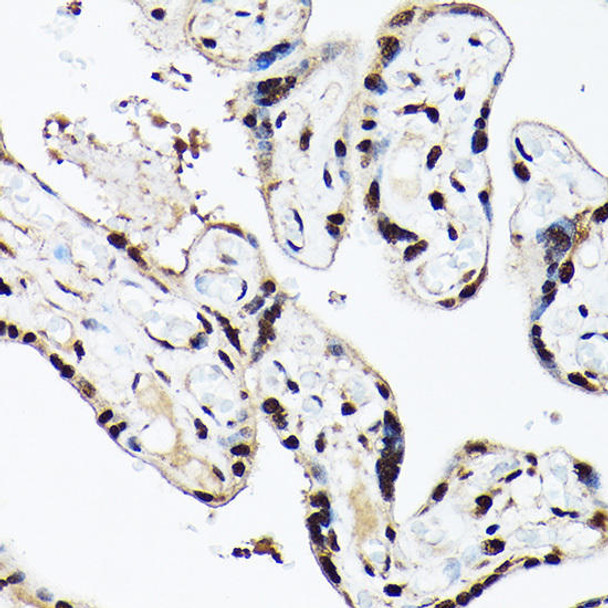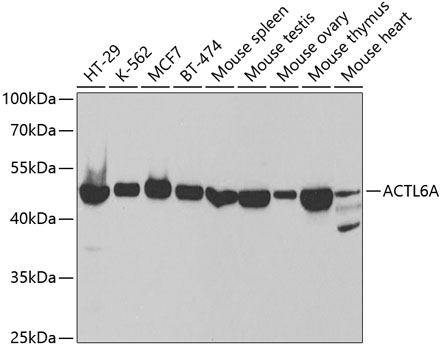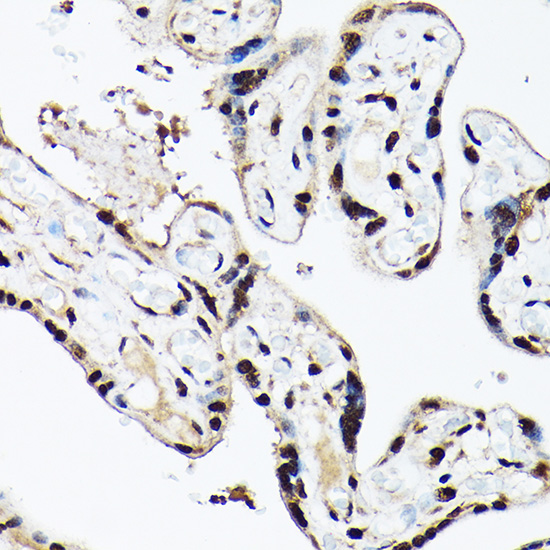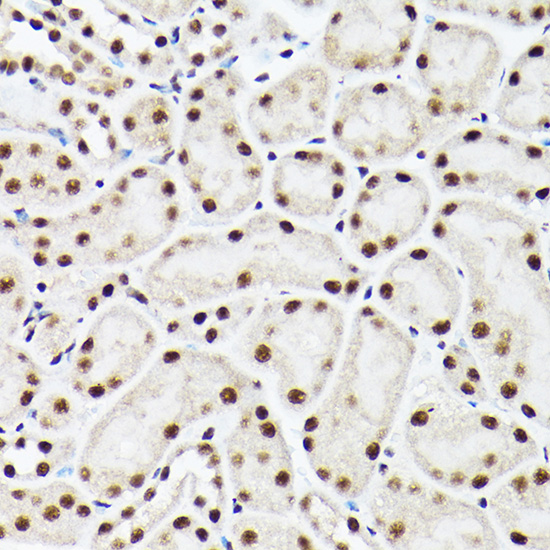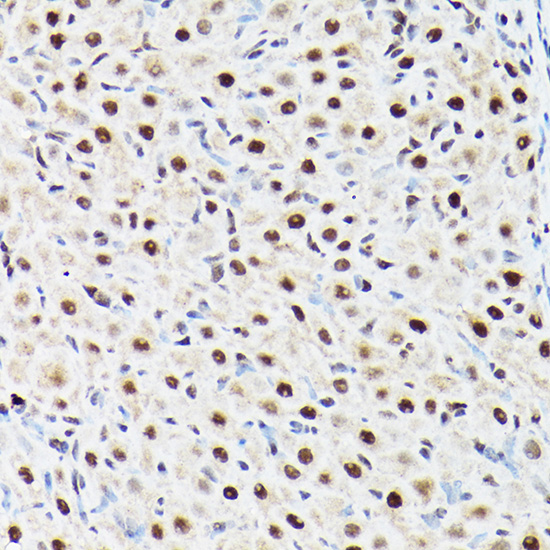Anti-ACTL6A Antibody (CAB5387)
- SKU:
- CAB5387
- Product type:
- Antibody
- Reactivity:
- Human
- Mouse
- Rat
- Host Species:
- Rabbit
- Isotype:
- IgG
- Antibody Type:
- Polyclonal Antibody
- Research Area:
- Epigenetics and Nuclear Signaling
Frequently bought together:
Description
| Antibody Name: | Anti-ACTL6A Antibody |
| Antibody SKU: | CAB5387 |
| Antibody Size: | 20uL, 50uL, 100uL |
| Application: | WB IHC |
| Reactivity: | Human, Mouse, Rat |
| Host Species: | Rabbit |
| Immunogen: | Recombinant fusion protein containing a sequence corresponding to amino acids 1-280 of human ACTL6A (NP_004292.1). |
| Application: | WB IHC |
| Recommended Dilution: | WB 1:500 - 1:2000 IHC 1:50 - 1:200 |
| Reactivity: | Human, Mouse, Rat |
| Positive Samples: | HT-29, K-562, MCF7, BT-474, Mouse spleen, Mouse testis, Mouse ovary, Mouse thymus, Mouse heart |
| Immunogen: | Recombinant fusion protein containing a sequence corresponding to amino acids 1-280 of human ACTL6A (NP_004292.1). |
| Purification Method: | Affinity purification |
| Storage Buffer: | Store at -20°C. Avoid freeze / thaw cycles. Buffer: PBS with 0.02% sodium azide, 50% glycerol, pH7.3. |
| Isotype: | IgG |
| Sequence: | MSGG VYGG DEVG ALVF DIGS YTVR AGYA GEDC PKVD FPTA IGMV VERD DGST LMEI DGDK GKQG GPTY YIDT NALR VPRE NMEA ISPL KNGM VEDW DSFQ AILD HTYK MHVK SEAS LHPV LMSE APWN TRAK REKL TELM FEHY NIPA FFLC KTAV LTAF ANGR STGL ILDS GATH TTAI PVHD GYVL QQGI VKSP LAGD FITM QCRE LFQE MNIE LVPP YMIA SKEA VREG SPAN WKRK EKLP QVTR SWHN YMCN CVIQ DFQA SVLQ VSDS TYDE QVAA |
| Gene ID: | 86 |
| Uniprot: | O96019 |
| Cellular Location: | Nucleus |
| Calculated MW: | 43kDa/47kDa |
| Observed MW: | 48kDa |
| Synonyms: | ACTL6A, ACTL6, ARPN-BETA, Arp4, BAF53A, INO80K |
| Background: | This gene encodes a family member of actin-related proteins (ARPs), which share significant amino acid sequence identity to conventional actins. Both actins and ARPs have an actin fold, which is an ATP-binding cleft, as a common feature. The ARPs are involved in diverse cellular processes, including vesicular transport, spindle orientation, nuclear migration and chromatin remodeling. This gene encodes a 53 kDa subunit protein of the BAF (BRG1/brm-associated factor) complex in mammals, which is functionally related to SWI/SNF complex in S. cerevisiae and Drosophila; the latter is thought to facilitate transcriptional activation of specific genes by antagonizing chromatin-mediated transcriptional repression. Together with beta-actin, it is required for maximal ATPase activity of BRG1, and for the association of the BAF complex with chromatin/matrix. Three transcript variants that encode two different protein isoforms have been described. |
| UniProt Protein Function: | BAF53A: an actin-related protein involved in transcriptional activation and repression of select genes by chromatin remodeling (alteration of DNA-nucleosome topology). Required for maximal ATPase activity of the helicase SMARCA4 and for association of the SMARCA4 containing remodelling complex BAF with chromatin/nuclear matrix. A component of the NuA4 histone acetyltransferase (HAT) complex which is involved in transcriptional activation of specific genes. Two alternatively spliced human isoforms have been described. |
| UniProt Protein Details: | Chromosomal Location of Human Ortholog: 3q26.33 Cellular Component: NuA4 histone acetyltransferase complex; nuclear chromatin; nucleoplasm; nucleus; plasma membrane; protein complex; SWI/SNF complex Molecular Function:chromatin binding; nucleosomal DNA binding; protein binding Biological Process: ATP-dependent chromatin remodeling; chromatin remodeling; signal transduction |
| NCBI Summary: | This gene encodes a family member of actin-related proteins (ARPs), which share significant amino acid sequence identity to conventional actins. Both actins and ARPs have an actin fold, which is an ATP-binding cleft, as a common feature. The ARPs are involved in diverse cellular processes, including vesicular transport, spindle orientation, nuclear migration and chromatin remodeling. This gene encodes a 53 kDa subunit protein of the BAF (BRG1/brm-associated factor) complex in mammals, which is functionally related to SWI/SNF complex in S. cerevisiae and Drosophila; the latter is thought to facilitate transcriptional activation of specific genes by antagonizing chromatin-mediated transcriptional repression. Together with beta-actin, it is required for maximal ATPase activity of BRG1, and for the association of the BAF complex with chromatin/matrix. Three transcript variants that encode two different protein isoforms have been described. [provided by RefSeq, Jul 2008] |
| UniProt Code: | O96019 |
| NCBI GenInfo Identifier: | 23396463 |
| NCBI Gene ID: | 86 |
| NCBI Accession: | O96019.1 |
| UniProt Secondary Accession: | O96019,Q8TAE5, Q9BVS8, Q9H0W6, B3KMN1, D3DNR9, |
| UniProt Related Accession: | O96019 |
| Molecular Weight: | 43,236 Da |
| NCBI Full Name: | Actin-like protein 6A |
| NCBI Synonym Full Names: | actin like 6A |
| NCBI Official Symbol: | ACTL6A |
| NCBI Official Synonym Symbols: | Arp4; ACTL6; BAF53A; INO80K; ARPN-BETA |
| NCBI Protein Information: | actin-like protein 6A |
| UniProt Protein Name: | Actin-like protein 6A |
| UniProt Synonym Protein Names: | 53 kDa BRG1-associated factor A; Actin-related protein Baf53a; ArpNbeta; BRG1-associated factor 53A; BAF53A; INO80 complex subunit K |
| Protein Family: | Actin-like protein |
| UniProt Gene Name: | ACTL6A |
| UniProt Entry Name: | ACL6A_HUMAN |

